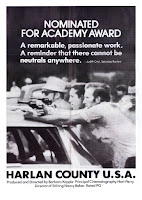 I’ve found myself picking up Keywords: A Vocabulary of Culture and Society by Raymond Williams frequently this semester – both to review for my Theories of Art lectures and to help prepare for a new seminar I’ll be teaching in Spring Semester, 2010 on art and public policy. Williams’ book is indispensable and hilariously brilliant. Each entry is a full-fledged essay on a word, including a study of derivation, competing uses and relationships to others words. My favorite: his winning trifecta on representation, realism and naturalism.
I’ve found myself picking up Keywords: A Vocabulary of Culture and Society by Raymond Williams frequently this semester – both to review for my Theories of Art lectures and to help prepare for a new seminar I’ll be teaching in Spring Semester, 2010 on art and public policy. Williams’ book is indispensable and hilariously brilliant. Each entry is a full-fledged essay on a word, including a study of derivation, competing uses and relationships to others words. My favorite: his winning trifecta on representation, realism and naturalism.
To start with, his definition of art is gloriously down to earth. Williams doesn’t tell us what we want words to mean. In a kind of Wittgensteinian mad clarity, he patiently documents the actual usage through the ages. Here’s a sampling plucked from the beginning, middle and end of his two page 'art' entry (citations omitted, some abbreviations spelled out):
Art has been used in English from the 13th Century. It was widely applied without predominant specialization, until the late 17th Century, in matters as various as mathematics, medicine and angling. In the medieval university curriculum, the arts… were grammar, logic, rhetoric, arithmetic, geometry, music and astronomy. Artist, from the 16th Century on, was first used in this context, though with almost contemporary developments to describe any skilled person. [….]
The emergence of an abstract, capitalized Art, with its own internal but generalized principles, is difficult to localize. There are several plausible 18th Century uses, but it was in the 19th Century that the concept became general. [....]
It can be primarily related to the changes inherent in capitalist commodity production…[as a]…defensive specialization of certain skills and purposes…not determined by immediate exchange (value)….This is the formal basis for the distinction between ….fine arts and useful arts. [....]
As these practical distinctions are pressed, within a given mode of production, art and artist acquire ever more general (and more vague ) associations, offering to express a general human (i.e. non-utilitarian) interest, even while, ironically, most works of art are effectively treated as commodities and most artists, even when they justly claim quite other intentions, are effectively treated as a category of independent craftsmen or skilled workers producing a certain kind of marginal commodity.
The book was published in 1976 and updated in 1983. Williams famously had no tolerance for post-modernism and the book does not take on the then-emerging vocabulary of late twentieth century criticism. Keywords is the work of a dogged Marxist modernist with a razor sharp mind and an awe-inspiring capacity for research.
A couple of other similar projects on my shelf that are more up-to-date, but in no way replace Williams' book: A Concise Glossary of Cultural Theory by Peter Brooker (Arnold, 1999) and the more extensive Cultural Theory, The Key Concepts by Andrew Edgar & Peter Sedgwick (Routledge, 2002).
 This is the worst, best logo I have ever seen. It's perfect for the US Chamber of Commerce. Free enterprise has run over the flag with a Hummer. The nation's regulatory apparatus is a carcass waiting to be scraped off the highway. What were they thinking? Aside from the obvious substantive dissonance, it's a thoroughly wretched bit of design. The deep shadow behind the splatter appears mindless and irrelevant. Is floating road kill more appealing? Surely this bloody pulp of a pennant can't be trying to wave? There is a different version on their website that emphasizes the ethereal light at the expense of the shadow. Among it's other charms, consider also the logo's vapid, sloppy exploitation of familiar twentieth century art -- gestural painting, drips, Jasper Johns, Robert Frank and, perhaps, especially Claes Oldenburg's 1960 USA Flag. I'm having fun imagining the internal Chamber meetings in which the merits of this design were pitched and debated. BTW, what's the USCC's position on flag desecration legislation, constitutional amendments, etc.? Lucky for them, the Supreme Court thinks it's protected speech. Texas v. Johnson (1989)
This is the worst, best logo I have ever seen. It's perfect for the US Chamber of Commerce. Free enterprise has run over the flag with a Hummer. The nation's regulatory apparatus is a carcass waiting to be scraped off the highway. What were they thinking? Aside from the obvious substantive dissonance, it's a thoroughly wretched bit of design. The deep shadow behind the splatter appears mindless and irrelevant. Is floating road kill more appealing? Surely this bloody pulp of a pennant can't be trying to wave? There is a different version on their website that emphasizes the ethereal light at the expense of the shadow. Among it's other charms, consider also the logo's vapid, sloppy exploitation of familiar twentieth century art -- gestural painting, drips, Jasper Johns, Robert Frank and, perhaps, especially Claes Oldenburg's 1960 USA Flag. I'm having fun imagining the internal Chamber meetings in which the merits of this design were pitched and debated. BTW, what's the USCC's position on flag desecration legislation, constitutional amendments, etc.? Lucky for them, the Supreme Court thinks it's protected speech. Texas v. Johnson (1989)

 Just an update on the
Just an update on the 












+of+video+green+chris+kraus.jpg)



